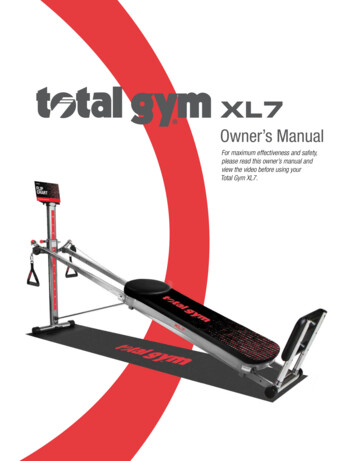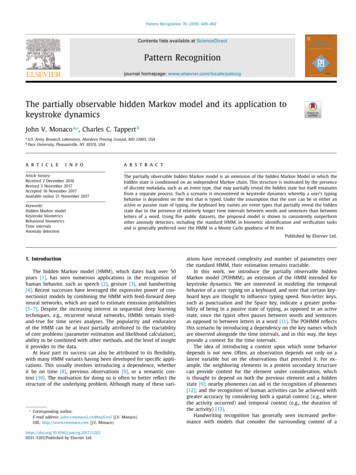
Transcription
INTERNATIONAL JOURNALOF THE FIA: ISSUE #2ROAD TO RUINTravelling one of the world’smost dangerous highways inBangladesh and how the FIAis helping reduce the risk P34THE BEAR ROARSFrom taking road safety tothe global stage to buildingnew arenas for world motorsport, Russia is rising P50REVIVING THE EUROFormerly unloved anduncompetitive, the EuropeanRally Championship hashad a major makeover P62AUTO PILOT PROJECTSOnce the stuff of science fiction,autonomous cars are close tobecoming the comfortable andsafe future of motoring P68P42CRUNCH TIMEBehind closed door at the FIAcrash tests that keep Formula One safe
BEHIND THE SCENESISSUE#2THE FIAINTERNATIONALJOURNAL OF THE FIAEditorial Board:JEAN TODT, NORMAN HOWELL,GERARD SAILLANT, RICHARD WOODS,TIM KEOWN, DAVID WARDEditors-in-chief:NORMAN HOWELL, RICHARD WOODSExecutive Editor: MARC CUTLERThe Fédération Internationalede l’Automobile is the governingbody of world motor sport and thefederation of the world’s leadingmotoring organisations. Foundedin 1904, it brings together 232national motoring and sportingorganisations from 134 countries,representing millions of motoristsworldwide. In motor sport,it administers the rules andregulations for all internationalfour-wheel sport, including the FIAFormula One World Championshipand FIA World Rally ChampionshipEditor: JUSTIN HYNESCopy Editor: JOHN LILLEYArt Direction and Design HELEN NILANDPhoto Editor: CASDesign Consultant: JAMES GREENHOWContributors: MATT BEER, GEMMA BRIGGS,ANNIE KELLY, ANTHONY PEACOCK,MATT YOUSONLogistics: KATE ROBSONRepro Manager: ADAM CARBAJALPrinting: MANOR CREATIVEWe would like to thank the followingfor their help with this issue of AUTO:JAMES BRADFORD, DMITRY EROFEEV,DIANA FAUNER, LUCY GENON,AURELIE JEGOU, SVETLANA LYSYAKOVA,TATIANA MAHINA, ANDY MELLOR,THE FIA FOUNDATIONThe FIA Foundation is anindependent UK registered charitythat supports an internationalprogramme of activities promotingroad safety, the environmentand sustainable mobility. It wasestablished in 2001 with a donationof 300 million from the FIAand is governed by a Board ofTrustees. Among its activities, theFoundation participates in variousUN road safety and environmentrelated partnerships and is amember of the UN Global RoadSafety Collaboration.VADIM MELNIKOV, NEIL MOSS, MIKE NORTON,KIM PALMER, JOHN PAP, IAN ROBERTS,AVI SILVERMAN, VINCENT ST CLAIR,CHARLIE WHITINGSpecial thanks to all at theTRANSPORT RESEARCH LABORATORYfor their help with the cover imageLegal: 2013 FIA. All rights reserved. Except to the extentpermitted under applicable copyright laws, no part of theinformation found in this publication may be reproducedor distributed in any form or by any means, or stored ina data base or retrieval system, without the prior writtenpermission of the FIA.Cover image: WILL THOM04/84THE FIA INSTITUTEThe FIA Institute is an internationalnot-for-profit organisation thatdevelops and improves motorsport safety and sustainability.It leads projects that encouragethe rapid development of newand improved safety technologies;that facilitate higher standardsof education and training;and that raise awareness ofsafety and sustainability issues.The Institute was establishedin October 2004 and funds itsactivities through annual grantsfrom the FIA Foundation.In motor sport, the racing isjust the tip of the iceberg, theculmination of months oftechnical work to ensure bothcar and driver have reachedthe highest standards.This is never more the case than where safety isconcerned. In this issue of AUTO we go behind thescenes of Formula One crash tests that take placethroughout the off-season. Each car must pass 18different crash and stress tests — that’s 198 passes justso F1 cars can go racing. It’s an essential element ofthe sport, and we reveal all.Motor racing is also a great leveller. It is one of thefew sports in the world where men and women,abled and disabled, young and old, compete on thesame field of play. And this month we look at howa group of disabled soldiers conquered the Dakar.Alex Zanardi also tells us what it takes to makea champion — unsurprisingly, it has little to do withphysical attributes and much to do with passion.It isn’t just on the track that such passions are tobe found either. Russia’s General Victor Kiryanov tellsus about his mission to ensure that road safety is atthe top of the political agenda in the world’s leadingcountries. We also visit one of the most dangerousroads in the world, Bangladesh’s N2, and hear froma group of experts determined to put things right.Such passions are worth championing — as we dothroughout this issue of AUTO.05/84
68From the roads and tracks of Russia to the crashtests that keep F1 drivers safe — this is AUTOContents51NEWS P12 - P17The stories making the headlines from across motor sport and motoring include ASEANNCAP’s first road car crash tests, Hyundai’s up-and-running hydrogen fuel-cell car,and the FIA’s determination to keep road safety at the top of the global political agendaANALYSIS P19 - P27P19 ALEX ZANARDIThe double Paralympics gold medallist challenges all sportsmen to show more passionP20 THE BIG QUESTIONExperts discuss how cars and the way we drive will change over the next 20 yearsP22 SIZE MATTERSHow a tiny sensor could hugely improve safety for drivers in Formula One and beyondP26 FORMULA FOR SAFETYFord is introducing Formula One-level safety standards to its junior racing series62FOCUS P28 - P77P28 READY, WILLING AND ENABLEDIn motor sport the disabled compete on equal terms, as these Dakar entrants prove‘OUR GOAL IS TO PREVENTTRAFFIC ACCIDENTS, FREEUP PEOPLE’S TIME ANDREDUCE CO2 EMISSIONSBY CHANGING CAR USE’P34 THE WORLD’S MOST DANGEROUS ROADA trip along Bangladesh’s deadliest highway, the 123-mile N2 from Dhaka to SylhetP42 CRUNCH TIMEBehind the scenes at the crash test programme all F1 cars must pass before they raceP51 RUSSIA: SPECIAL REPORTFrom road safety to motor sport, Russia is making huge strides at home and abroadP62 REVIVING THE EURO RALLYThe European Rally Championship is reborn – and will lead directly into the WRC42PROF SEBASTIAN THRUN — GOOGLEP68 SWITCHING TO AUTO PILOTNo longer the stuff of sci-fi, driverless cars are a reality and motoring’s next leap forwardP74 THE FUEL PRESSURE IS ONA report reveals that most countries are not doing enough to cut fuel consumptionFINISH P78 - P82P78 FREEZE FRAMEReliving the Monte-Carlo Historique rally at the wheel of a Renault Alpine A110P80 STATS AT THE BACKFormula One’s top 50 sponsors – the biggest are not always the boldestP82 BACK TO THE FUTUREMeet Formula One’s new medical co-ordinator, the first doctor on any accident scene06/84191107/84
AUTO/MOTIVEAUTO/MOTIVEThe mix of ultra-light bodyweight and class-leadingaerodynamic efficiency –with its blend of retro andfuturistic styling cues – makesVolkswagen’s XL1 as eyecatching as it is revolutionary.Hybrid electric/diesel powerhelps to extend its on-roadrange, but it is still capableof achieving a claimed130-140mpg when runningon diesel aloneSustainabilityAERODYNAMIC08/84PHOTOGRAPHY: TOYOTA MOTORSPORTTEXT:TEXTTEEXEXXTT: XXXXXXXXXXXXXXXXXXXXXX PHOTO:PHOTOOTOO: XXXXXXXXXXXXXXXXXXXXXXVolkswagen has revealed details of a newproduction vehicle that it claims is the world’smost fuel-efficient car. The XL1 deliversvanishingly low fuel consumption figures ofjust 0.9l/100km, the equivalent of 313mpg.It was previously seen as a concept, but VWnow says it has confirmed the fuel figures andthat it will put the radical two-seater car intolimited production at its plant in Osnabrückin Germany later this year.The economy comes courtesy of the car’slow kerb weight, slippery aerodynamics andfrugal powertrain. The XL1 weighs in atjust 795kg thanks to a body – made mostlyof carbon-fibre-reinforced plastic and anultra-thin glass windscreen – that on its ownweighs just 230kg.The ‘retro-future’-styled XL1 is poweredby a plug-in hybrid system consisting ofan 800cc, two-cylinder turbodiesel enginegenerating 47bhp, and an E-motor thatdelivers 27bhp from a lithium-ion battery.Speed is limited to 160km/h, and the XL1will reach 100km/h (62mph) in a respectable12.7sec. In electric-only mode it will travelabout 30 miles (48km) on a single charge.When driven in diesel-only mode at normalmotorway speeds the car can still averagearound 130-140mpg, VW claims. That’s about250 miles (402km) on one 10-litre tankful.The aerodynamics are also interesting. Itsvery low drag coefficient of 0.189 is madepossible by innovations such as ‘e-mirrors’mounted in the doors, which project roadimages onto screens in the cabin where thetwo passengers sit in a slightly offset position.09/84
AUTO/MOTIVEAUTO/MOTIVE‘MY OWNSTORY CANHOPEFULLYTEACH OTHERSABOUT THELONG-TERMCONSEQUENCESOF SPEEDING’Road safetySAFE GUARDSAt the inaugural Doha GOALS sports businessforum, the sobering facts and figures behindroad accidents worldwide were discussed by theFIA president Jean Todt, the Make Roads Safeambassador Michelle Yeoh, and Williams F1founder Sir Frank Williams. They were speakingbefore an influential audience of governmentofficials, federation heads and policy makers.President Todt is responsible for the FIA’s Actionfor Road Safety campaign, which is addressingthe 1.3 million road deaths per year by urgingdrivers to follow 10 golden safety rules. Williamstalked of his experience as a high-profile victimof the dangers of the road, and the ways in whichFormula One can use its technology base toaddress the problem. The FIA is now playing aAt the Doha GOALSforum, FIA presidentJean Todt (secondfrom left), Sir FrankWilliams andMichelle Yeoh developtheir thoughts onthe contribution F1can make to everydayroad safety10/84PHOTOGRAPHY: DOHA GOALS / WWW.DOHAGOALS.COMSIR FRANK WILLIAMSkey role in adapting F1 technology to road safetyapplications. Its Technology Centre in Qatar hasdeveloped advanced road safety simulators that arebeing used to train and certify ordinary road usersand so reduce the death toll on Qatari roads.“Road safety is an important issue for me and forWilliams as an organisation,” said Sir Frank.“I was delighted to be speaking alongside Jean andMichelle and to help raise awareness of this crucialissue. My own story can hopefully teach others thelong-term consequences of speeding. It was alsoan opportunity to speak about the role FormulaOne can play with the advanced technology it hasproduced. Hopefully our road safety simulatorscan help reduce the number of deaths and seriousinjuries on Qatari roads in the future.’’11/84
AUTO/ROUTESAUTO/ROUTESEx-F3 driver JulesBianchi (left andbelow) tested forthe Scuderia in 2009before joining its testteam, and now he haslanded a 2013 F1 raceseat with Marussia;F3 is stacked witheager talent, suchas Tom Blomqvist(bottom left)who will race forEurointernationalin this year’s FIAEuropean F3 seriesStories making theheadlines from theworld of the FIA familyNewsVolvo unveilscycle-detectionbraking system12/84Next European Formula 3champion to getFerrari Formula One testBy the end of the FIA’s 2013 Formula 3European Championship season, one luckydriver will have won a potentially careerchanging prize: an F1 test drive with Ferrari.The series, which kicks off at Italy’s Monzacircuit on March 22, has already attracteda highly competitive field, and the FIAis on course to establish the championshipas a major rung on a proposed ladderleading from karting to top-level seniormotor sport.According to the FIA single-seatercommission president, Gerhard Berger,the chance to spend a day with the FerrariDriver Academy and drive a Formula Onecar confirms the value of the series both toPHOTOGRAPHY: CHARNIAUX / XPB IMAGES / LAT; DPPISwedish car manufacturer Volvo haslaunched new cyclist detection technologyat the 2013 Geneva Motor Show. Carsequipped with the new feature – Volvo’slatest bid to avoid accidents before theyhappen – will detect, and automaticallybrake for, any cyclist who may swerve infront of the car.The new software is an enhancement ofthe company’s present pedestrian detectionand brake technology and will be fitted to arange of models from this May.According to accident data, about 50 percent of all cyclists killed in European traffichave collided with a car. This latest systemincludes more rapid vision processing tocover cyclists’ behaviour.The advanced sensor scans the areaahead. If a cyclist heading in the samedirection suddenly swerves in front of the caras it approaches from behind, and a collisionis imminent, an instant warning is issued andfull braking power is applied.“Our solutions for avoiding collisionswith unprotected road users are unique inthe industry,” said Volvo’s vice presidentof marketing, Doug Speck. “By coveringmore and more objects and situations, wekeep moving towards our long-term goal ofdesigning cars that do not crash.”up-and-coming racers and to the teams.“When we took the decision to get theFormula 3 European Championship upand running again, we had a single aim inmind: to give the best rising talents theopportunity to shine,” said Berger. “AsFormula One is obviously the ultimate aimfor a young driver, it seemed to us to bevery important to reward the championwith an F1 drive. We’re delighted to havereached this agreement with the FerrariDriver Academy.“A driver has very few chances to getbehind the wheel of such a car,” he added.“It’s a great opportunity and one the 2013winner will surely make the very most of.He’ll learn more, he’ll get himself noticed,and he’ll show that tomorrow’s F1 driversare in Formula 3 today.”Luca Baldisserri, head of Ferrari’s DriverAcademy added: “The Ferrari DriverAcademy firmly believes that a Formula3 car is an excellent preparatory car andthat every driver’s career should include aspell in one, because of the special balancebetween grip and power, which is ideal forlearning to drive a single-seater.“This is why we choose to reward thewinner with what is a dream for everyracing driver, namely a day at the wheelof an F1 Ferrari.”McLaren winsenvironmentalrecognitionVodafone McLaren Mercedes is the firstmotor sport stakeholder in the world toreceive the FIA Institute’s EnvironmentalAward for the Achievement of Excellence.The award is part of an initiative aimedat reducing the environmental impact ofmotor sport. It is the highest level attainablewithin the FIA Institute SustainabilityProgramme, which helps stakeholders tomeasure, improve and be recognised fortheir performance.Underpinning the Sustainability Programmeis an environmental accreditation scheme –the Environmental Certification Framework– the first to have been developed specificallyfor motor sport. It enables National SportingAuthorities, teams, circuits, manufacturers,and event organisers to achieve the higheststandards in environmental management.FIA president Jean Todt said: “McLaren’saward is an important step in the recognitionby motor sport of the social responsibility ourcommunity must acknowledge.”FIA Institute president Gerard Saillantsaid: “This is a fantastic achievement for amotor sport organisation, especially as theassessment is based on leading standardsacross all industries.”The FIA Institute’s EnvironmentalCertification Framework has been developedin partnership with leading environmentalconsultancy Det Norske Veritas (DNV), andthe Institute’s Sustainability Advisory Panel,composed of environmental experts fromacross motor sport. The accreditation processitself is led by FIA Institute environmentalconsultant Even Wiger.Achieving the excellence accreditation is noeasy task. McLaren’s head of sustainability,Ian MacDonald, said: “We pride ourselveson our environmental credentials but the FIAInstitute assessment really put those to thetest. As a result, we have made major changesto further improve the team’s sustainability.”13/84
AUTO/ROUTESAUTO/ROUTESFIA ordersroad safetyaction studyDrivers will beable to competefor selection tothe Academy inqualifying eventsin their own regionMeeting of minds:Jim Yong Kim andLord Robertsondiscuss extrafunding resourcesCommissiondiscusses safetywith World BankAcademy spreads selection worldwide14/84drivers regardless of where they’re from.With regional selection events also includingvaluable training we look forward to manymore drivers having the opportunity tobenefit from this important programme.”With the provision of an event subsidy,qualifiers will be hosted by NationalSporting Authorities (ASNs) worldwide.However, the first of these events, in Europe,will be run by Academy training partnersESP and TTI. This event will become themodel for others to follow, and potentialhost ASNs will be invited to attend to gainimportant experience which will help themwith the running of their own events.Each qualifier event will produce onewinner who’ll go forward to the 2013 YoungDriver Excellence Academy. Further driverswill be selected using a wildcard system,bringing the total to eight participants in thefinal Academy group.Those drivers not selected for the final willstill benefit from the selection process, aseach will receive driver training as part of athree-day workshop.Every ASN in each region can nominateone driver for the selection event. ASNswill be provided with selection criteria tohelp them evaluate driver suitability and toensure that all nominated drivers at leastmeet minimum criteria.Gerard Saillant, FIA Institute president,said: “The Academy programme has been a‘WE NOW HAVEA TRULY GLOBALPLATFORM’ALEX WURZgreat success in its first two years and nowwe want to increase its regional reach. Tohelp with this we’ll be encouraging our ASNsworldwide to host qualifying events and wewill in turn help them to develop trainingservices for young drivers.”Application details for the selection eventswill be announced shortlyPHOTOGRAPHY: MCLARENThe FIA Institute has expanded its selectionprocess for its Young Driver ExcellenceAcademy. Up to five qualifying events willbe run in several countries later this year.The new format will provide many moreyoung drivers with the opportunity toapply for entry, which offers a fully-fundedtraining programme to help develop theirmotor sport careers as well as improvesafety skills and promote fairness andresponsibility on and off the track.Drivers will be able to compete forselection locally as qualifying events takeplace in widely varying geographical regions– the Americas, Europe, Asia/Pacific, theMiddle East and Africa.The Academy itself will run on similarlines to previous years, albeit with a smaller,more focused group of eight drivers takingon the training programme. Once againthey will benefit from the expert tutelage ofAlex Wurz, former Formula One driver andtwo-time Le Mans winner, and Robert Reid,former World Rally Champion.“This is an exciting development forthe Academy,” said Alex Wurz. “Now wehave a truly global platform on which towelcome the most worthy drivers. Successfulapplicants won’t just be those with the mostskill, but also the right approach and, mostimportant, the right attitude towards safety.”Robert Reid added: “We wanted to expandthe learning from the Academy to far moreAt a meeting in Washington in February todiscuss road safety and the post-2015 agenda,Lord Robertson of Port Ellen, chairman of theCommission for Global Road Safety, and thepresident of the World Bank, Jim Yong Kim,emphasised the urgent need to find sourcesof additional catalytic funding to supportcountry-led road injury prevention efforts.Also attending were David Ward, directorgeneral of the FIA Foundation, and KevinWatkins, a senior fellow at the BrookingsInstitution and member of the Commission forGlobal Road Safety.They discussed progress on the UN Decadeof Action for Road Safety and the efforts ofmultilateral development banks to integrateroad safety performance indicators into roadinfrastructure loan programmes. The positiveexample here was Argentina, where a standalone World Bank loan is now supporting roadsafety interventions by the government asthey drive down injuries.Lord Robertson said: “We’re not afraidto criticise the Bank when we perceiveshortcomings, but we recognise that it isone of the global policy leaders in sustainabletransportation, climate change and health.So I’m delighted that the World Bank istaking the road injury problem very seriouslyand committing to play its full part. This willbe crucial in the context of the post-2015sustainable development agenda, where thekey enabling role of transportation policy indelivering health, education, climate and otherenvironmental targets must be recognised.”The FIA has commissioned a study todetermine how road safety can be keptat the top of political agendas worldwide.The report will provide governments andorganisations with a road map of routes toensuring safer road use in their countries.The study will be undertaken by Holland’sSWOV Institute for Road Safety Researchand, at a meeting in Paris to kickstart theinitiative, FIA president Jean Todt said: “Alot of things have been done [to promoteroad safety] but we need to do more. Road[death and injury] is a major scourge. WhenI see the input given to tuberculosis, HIVand malaria by governments worldwide, Ifeel those issues are being dealt with in anappropriate manner. For me, road safety isnot being addressed as it should be.”During a two-day meeting, senior FIAMobility personnel, SWOV representativesand a panel of road safety experts definedthe parameters of a report to be delivered inthe autumn. Commenting on the discussionsFIA secretary general for Automobile Mobilityand Tourism Susan Pikrallidas (below) saidthe study would aim to deliver in three areas.“First, a background paper on road safetyissues and strategies to get governments,especially those in developing countries,to fully grasp the importance of investingin road safety,” she said. “Also a shortsummary document to be used by the FIApresident to communicate the road safetymessage to global leaders in government,the investment community, and internationalorganisations. Finally, it will also develop a‘toolbox’ of actions for our members.”SWOV’s MD, and professor of trafficsafety at Delft University of Technology,Fred Wegman, said that with the scope ofthe report now defined, the hard work couldbegin. “As an institute, we have received alot of homework from the experts,” he said.Todt holds roadsafety talkswith Israeli PMOn a visit to Israel, FIA president Jean Todtheld talks on road safety issues with theprime minister, Benjamin Netanyahu (above).Todt was in Israel to speak at the annualconference of the Or Yarok Association, aroad safety NGO founded in 1997 by AviNaor, whose 20-year-old son was killed ina traffic accident. Since its inception theassociation has played a major role in raisingpublic awareness of road safety. As theresult the Israeli government has passedcomprehensive legislation, putting it amongthe top 10 countries for road safety. In 2012its road toll hit a historic low of 292 deaths.Addressing the conference alongsideGlobal Road Safety ambassador MichelleYeoh, president Todt praised the associationfor helping to reduce road fatalities, and saidthe country was a good example of what canbe achieved when there is “commitment andpolitical will”. He also called for such politicalinvolvement on an international scale.“While road safety is and will remain firstand foremost a national responsibility, myconviction is that there is a growing role forthe international community to play,” hesaid. “Until very recently, road safety wasconsidered merely as a national issue, butroad accidents are becoming such a massivescourge – especially in emerging anddeveloping countries – that it is one of thegreatest challenges the world is facing today,both in human and development terms.”Todt later met with prime ministerNetanyahu to discuss the importance ofputting road safety firmly at the top of theinternational political agenda. They alsotalked about the possibility of using motorsport to develop mutual understanding andtolerance in the region.15/84
AUTO/ROUTESAUTO/ROUTESNissan tooffer e-safetyelementsto smallcar sectorNissan’s new Note supermini (below)will offer a suite of e-safety technologiesnormally reserved for the premium sector.The new small-sector car, which made itsdebut at the Geneva motor show and whichwill be available this autumn, features a packNissan is calling the Safety Shield, whichnot only features the company’s AroundView Monitor system – with camera anglesviewable on a 5.8 touchscreen – but also arange of other technologies including BlindSpot Warning, Lane Departure Warning andMoving Object Detection systems whichtogether have been designed to create avirtual ‘safety net’ around the vehicle.With the systems working together, thecar alerts drivers to objects moving behindthe car, such as a child walking towards youwhen reversing. It also warns drivers whenvehicles are in their blind spot, and it detectswhen another car is drifting out of its lane soavoiding action can be taken.A neat convenience item is the selfcleaning rear camera. It scans itself for dirtand if it needs to be cleaned a small jet ofwater is fired onto the lens which is thendried with a puff of compressed air.‘A SAFETY NETIS PUT AROUNDTHE VEHICLE’16/84Make RoadsSafe presentsevidence to UNHyundai firesup hydrogenfuel cellproduction lineHyundai is the first car manufacturer to beginassembly-line production of zero-emissionshydrogen-powered vehicles for fleet use,with the launch of its ix35 Fuel Cell vehicle.The new car rolled off Hyundai’s Ulsanproduction line last month and will initially beshipped to Europe to fleets in Copenhagen,Denmark and Skåne, Sweden. TheMunicipality of Copenhagen, as part of itsinitiative to make itself carbon-free by 2025,will be supplied with 15 ix35 Fuel Cell carsfor fleet use. Two will go to Skåne.“With the ix35 Fuel Cell vehicle, Hyundaiis leading the way to a zero-emissionsfuture,” said Hyundai Motors vice chairman,Eok-Jo Kim. “The ix35 Fuel Cell is the mosteco-friendly vehicle in the auto industry andproves that hydrogen fuel cell technology indaily driving is no longer a dream.”Hyundai plans to build 1,000 ix35 Fuel Cellcars by 2015 for lease to public and privatefleets, primarily in Europe, where the EU hasestablished a hydrogen road map and startedto build hydrogen fuelling stations.The UN’s High Level Panel on the Post-2015Development Agenda was given evidence bythe Make Roads Safe campaign on the globalroad traffic injuries crisis at its key meetingin Liberia from 30 January to 2 February.Presenting evidence on behalf of theMake Roads Safe campaign was BrightOywaya of Kenya (above), who is also arepresentative of the Association of thePhysically Disabled of Kenya.Oywaya was nominated by other civilsociety representatives to present to theHigh Level Panel at the main consultativesession on 30 January in the Liberian capital,Monrovia. The Panel of 27 has been taskedby UN secretary general Ban Ki-moon toadvise on a global development frameworkto replace the Millennium DevelopmentGoals that expire in 2015.It is co-chaired by president SusiloBambang Yudhoyono of Indonesia, presidentEllen Johnson Sirleaf of Liberia, and UK primeminister David Cameron. The meeting wasone of only three opportunities for NGOs toengage with the panel before it produces itsreport in May.Oywaya presented the case for road safetyto be included as a target within the post2015 framework for global development.“In representing the Make RoadsSafe campaign in Monrovia, this was arare opportunity to bring attention to anissue which has huge implications for thedevelopment agenda,” she said.“As I have seen in my country, road trafficinjury plunges families and communitiesfurther into poverty. And the human costis unacceptable – how can we not addresswhat is the number one killer of young peopleglobally? The inclusion of road safety withinthe wider development agenda post-2015would result in millions of lives saved andinjuries prevented. This is a crisis which canno longer be ignored.”ASEAN NCAP releasesfirst crash test scoresASEAN NCAP, the new car assessmentprogramme for South East Asia, has releasedthe first-ever crash test results for cars inthe region. They show encouraging progressby some manufacturers, but poor levels ofsafety at the bottom end of the scale.Two models – the Ford Fiesta and HondaCity – achieved five stars for adult occupantprotection. But the results of the Hyundaii10 (two stars) and Proton Saga (one star)show there is still much more that can andshould be done to improve vehicle safety.The testing is the result of a collaborationbetween the Malaysian Institute of RoadSafety Research (Miros) and Global NCAP.Other models tested under the ASEANNCAP off-set frontal collision protocol werethe Toyota Vios (four stars), Perodua Myvi(three stars), and Nissan March (four stars).All the cars were built in Malaysia, exceptthe Ford Fiesta and Nissan March, which areproduced in Thailand. To be eligible for afive-star rating, a vehicle must have at leasttwo airbags, electronic stability control anda seatbelt reminder, or its limit is four stars.David Ward, secretary general of GlobalNCAP, said: “Consumers in the ASEANregion should expect the same levels ofsafety those with established crash testingprogrammes. These results show that it’sperfectly possible to produce affordable carswith top level safety for emerging markets.However, the disparity [between them] andmodels at the lowest end is worrying.”ASEAN NCAP is also supported by themembership of automobile associations fromMalaysia (AAM), the Philippines (AAP) andSingapore (AA Singapore).The Malaysian Government has appliedthe UN’s regulation for frontal impact to allnew passenger cars. This is in line with therecommendations on vehicle safety includedin the Global Plan of the Decade of Actionfor Road Safety.Miros launched its crash test laboratorywhen it hosted the largest-ever gatheringof NCAPs at the Global NCAP annualmeeting in May 2012. ASEAN NCAP carriedout frontal off-set crash tests at 64km/has it as
THE FIA INSTITUTE The Fédération Internationale de l'Automobile is the governing body of world motor sport and the federation of the world's leading motoring organisations. Founded in 1904, it brings together 232 national motoring and sporting organisations from 134 countries, representing millions of motorists worldwide.











